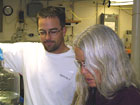

 | |||||||||||||||
|
|
Journals 2005/2006Denis Costello
July 14, 2005 We continued our general survey along the OZ line and then headed into the Strait to survey the JA line. During the day, the Principal Investigators got together with Dr. Hickey to determine when and where to start the "grid." The grid will be a second survey in which we will continually survey from the GH line (near the Columbia River) and proceed in a zigzag manner toward Barkley Sound in Vancouver Island. It's a stressful time because a decision needed to be made about where and when to start the grid. As of right now, we have not found significant amounts of Pseudo-nitzschia and the concentration of DA in the water has been negligible. Up to today, upwelling has been absent off the coast and the winds needed to move surface water from the shore have not been blowing. The latest weather reports predict that the winds should pick up, increasing the chances of upwelling. I learned from my conversations with the PIs that if a PN bloom was to occur, the water would turn into a fluorescent green color, similar to what you might expect to see in a cyalume glow-stick. Today we read on the Internet articles from the Seattle Times and the San Francisco Chronicle suggesting that with the long-term absence of upwelling, that the ecosystem in on the brink of collapse. The PIs hope that this is not the case. They will rely on satellite imagery from the SeaWIFS satellite to look for surface chlorophyll content as well as sea surface temperatures.
Normal sampling continued with CTDs, plankton net tows and water collection from the FISH. I worked my normal shift of 6am to 6pm, assisting with the recovery of the FISH at the end of the day. After my shift, we had an all-science crew meeting in the library of the Atlantis to divulge what has happened so far. As a group, we understand that the low amounts of PN may just mean that conditions are not right for a mass-scale bloom. We will continue to monitor information from satellites, moorings and drifters to try and predict how the movement of winds and currents might affect the conditions needed for a PN bloom.
|
||||||||||||||


